Machine Learning Projects to Practice in 2024
Explore some cool and innovative industry-based machine learning projects with source code that you can practice to develop your machine learning skills.

As an aspiring machine learning professional, a portfolio is the most important asset to have in your job search. But what if you don’t have a machine learning portfolio because you are going to need diverse skills and projects under your belt to land a top machine learning gig. ProjectPro partners with industry experts and machine learning practitioners to provide you with solved end-to-end innovative machine learning projects that can be a value add-on on your resume and showcase your machine learning skills to prospective employers. These ML projects cover a broad range of machine learning skills plus they can be reused to suit your business use case. Here is a rundown of our 8 latest amazing Machine Learning Projects for your resume that you must practice for August 2021 to set off your career in machine learning.

Table of Contents
- Machine Learning Projects to Practice with Source Code for October 2023
- 1) Recommender System Machine Learning Project for Beginners
- 2) OpenCV Project for Beginners to Learn Computer Vision Basics
- 3) OpenCV Project to Master Advanced Computer Vision Concepts
- 4) MLOps Project for a Mask RCNN on GCP using uWSGI Flask
- 5) Using Classification Algorithms for Digital Transformation[Banking]
- 6) Classification Projects on Machine Learning for Beginners
- 7) Deep Learning Project for Text Detection in Images using Python
- 8) FEAST Example for Scaling Machine Learning
- 9) Using CNN and Deep Transfer Learning for Image Colorization
Machine Learning Projects to Practice with Source Code for January 2024
1) Build CNN Image Classification Models for Real Time Prediction
2) Build a Multi-Class Classification Model in Python on Saturn Cloud
3) Build Regression (Linear,Ridge,Lasso) Models in NumPy Python
4) Deploy Transformer-BART Model on Paperspace Cloud
5) MLOps Project to Deploy Resume Parser Model on Paperspace
6) Learn Object Tracking (SOT, MOT) using OpenCV and Python
Machine Learning Projects to Practice with Source Code for December 2023
1) Build Deep Autoencoders Model for Anomaly Detection in Python
2) Build a Customer Churn Prediction Model using Decision Trees
3) Build Portfolio Optimization Machine Learning Models in R
4) Build a Graph Based Recommendation System in Python
5) AWS MLOps Project to Deploy a Classification Model [Banking]
6) Deep Learning Project for Time Series Forecasting in Python
7) Isolation Forest Model Example for Anomaly Detection in Python
Machine Learning Projects to Practice with Source Code for November 2023
1) Linear Regression Model Project in Python for Beginners Part 1
2) Detectron2 Object Detection and Segmentation Example Python
3) Tensorflow Transfer Learning Model for Image Classification
4) End-to-End Speech Emotion Recognition Project using ANN
5) ML Model Deployment on AWS for Customer Churn Prediction
6) AWS MLOps Project for ARCH and GARCH Time Series Models
7) Loan Eligibility Prediction Project using Machine learning on GCP
Here's what valued users are saying about ProjectPro

Gautam Vermani
Data Consultant at Confidential

Ameeruddin Mohammed
ETL (Abintio) developer at IBM
Not sure what you are looking for?
View All ProjectsMachine Learning Projects to Practice with Source Code for October 2023
October is here and we want you to be well prepared for the Machine learning job interviews that have been lined up for you this month. So, check out the list of challenging machine learning projects below that will help you in upgrading your skillset.
1) Recommender System Machine Learning Project for Beginners
If you have tried online shopping, you must have noticed that when you are checking out a product on an eCommerce site, there is a list of suggested products that you are presented with. To curate those suggestions list, these websites use recommender systems. In this project, you will be introduced to different types of recommendation systems and learn how to build a recommendation system from scratch.

Data Description
The dataset contains the following information about the products purchased by different users.
Invoice Number: This is the number that identifies a transaction.
Stock Code: This refers to the product ID.
Description: This describes the product that a user purchased.
Quantity: It specified the quantity of the item purchased.
Invoice Date: The date on which the transaction took place.
Unit Price: Price of one product.
Customer ID: It identifies the customer.
Country: The country where the transaction was performed.
Language Used: Python
Packages/Libraries: Pandas, NumPy, Matplotlib, Seaborn
Source Code: Recommender System Machine Learning Project for Beginners
Loan Eligibility Prediction Project using Machine learning on GCP
Downloadable solution code | Explanatory videos | Tech Support
Start Project2) OpenCV Project for Beginners to Learn Computer Vision Basics
Before exploring the applications of deep learning algorithms to develop computer vision systems, it is essential to understand basic image processing techniques. These techniques can be smoothly implemented using the open-source computer vision library, OpenCV. In this project, you will be introduced to basic image processing techniques like colour spacing and conversion, Image thresholding, Image smoothing, Morphological Transformation, Edge detection, etc.
Data Description: The data for this project has three sample images (jpg) and a video (mp4).
Language Used: Python
Packages/Libraries: NumPy, Matplotlib, cv2(OpenCV)
Source Code: OpenCV Project for Beginners to Learn Computer Vision Basics
3) OpenCV Project to Master Advanced Computer Vision Concepts
Image Processing methods form the base of computer vision applications. So, to master computer vision, it is necessary to learn these methods. In this project, you will use the open-source computer vision library, OpenCV to learn how to perform background subtraction, CamShift, MeanShift, Color Quantisation, De-noising, etc. on different images in a dataset.
Data Description: This project will use sample images and videos as input data.
Language Used: Python
Packages/Libraries: NumPy, Matplotlib, cv2(OpenCV)
Source Code: OpenCV Project to Master Advanced Computer Vision Concepts
4) MLOps Project for a Mask RCNN on GCP using uWSGI Flask
MLOps refers to Machine learning operations that represent different methodologies, techniques, and procedures used to automate the deployment and handling of machine learning algorithms. With so many companies gradually diverting to machine learning methods, it is important for data scientists to explore MLOps projects and upgrade their skills. In this project, you will work on Google’s Cloud Platform (GCP) to build an Image segmentation system using Mask RCNN deep learning algorithm.
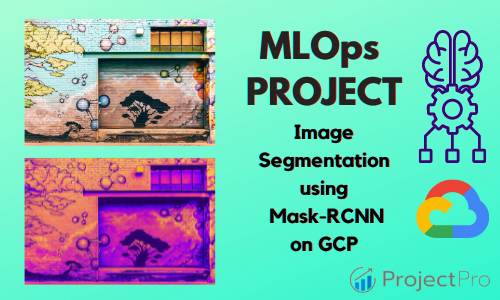
Data Description: For this project, you will use 20 images for the training set and 10 images for the validation set, and one image for the testing set. These images can be JPG, PNG, TIF formats.
The dataset has an annotation file named ‘Via_project.json’ that contains the region of interest (ROI) marked.
Language Used: Python
Services: GCP, uWSGI, Flask, Kubernetes, Docker
Packages/Libraries: TensorFlow, Mrcnn, Matplotlib, os, Flask
Source Code: MLOps Project for a Mask R-CNN on GCP using uWSGI Flask
5) Using Classification Algorithms for Digital Transformation[Banking]
The business model of banks is to have borrowers and depositors associate with them so that they can use the money of depositors to lend money to borrowers at specific interest rates. Thus, banks need to have a decent number of borrowers to generate profits. That requires them to invest in marketing techniques to have a higher number of borrowers as their customers. In this project, you will use classification machine learning algorithms to characterize potential customers.
Data Description: The data is contained in two different CSV files.
One file has 5000 rows and 8 columns and another has 5000 rows and 7 columns
The dataset has the following features:
ID: Customer ID
Age: Customer’s approximate age.
CustomerSince: Customer of the bank since.
HighestSpend: Customer’s highest spend so far in one transaction.
ZipCode: Customer’s zip code.
HiddenScore: A score associated to the customer which is masked by the bank as an IP.
MonthlyAverageSpend: Customer’s monthly average spend so far.
Level: A level associated with the customer which is masked by the bank as an IP.
Mortgage: Customer’s mortgage.
Security: Customer’s security asset with the bank.
FixedDepositAccount: Customer’s fixed deposit account with the bank.
InternetBanking: if the customer uses internet banking.
CreditCard: if the customer uses the bank’s credit card.
LoanOnCard: if the customer has a loan on the credit card.
Language Used: Python
Packages/Libraries: NumPy, pandas, matplotlib, seaborn, sklearn, pickle, imblearn
Source Code: Build Classification Algorithms for Digital Transformation[Banking]
6) Classification Projects on Machine Learning for Beginners
In machine learning classification problems are a special type of problem that falls under the category of supervised learning. The task is to assign the set of features in a dataset a label for a specific category that it belongs to. The target variables in such problems can thus take only limited values. In this project, you will be introduced to a variety of machine learning algorithms by working on building a spam classification system.
Data Description: The dataset that will be discussed here is a licensed dataset.
It has data of 85895 different businesses contained in 32 various features. The 32 features are ID, LICENSE ID, ACCOUNT NUMBER, SITE NUMBER, LEGAL NAME, DOING BUSINESS AS NAME, ADDRESS, CITY, STATE, ZIP CODE, WARD, PRECINCT, WARD PRECINCT, POLICE DISTRICT, LICENSE CODE, LICENSE DESCRIPTION, LICENSE NUMBER, APPLICATION TYPE, APPLICATION CREATED DATE, APPLICATION REQUIREMENTS COMPLETE, PAYMENT DATE, CONDITIONAL APPROVAL, LICENSE TERM START DATE, LICENSE TERM EXPIRATION DATE, LICENSE APPROVED FOR ISSUANCE, DATE ISSUED, LICENSE STATUS CHANGE DATE, SSA, LATITUDE, LONGITUDE, LOCATION, LICENSE STATUS.
LICENSE STATUS is the target variable which has five different categories as mentioned below.
AAI - License status is issued
AAC - License status is cancelled
REV - License status is revoked
REA - License status is revoked and appealed
INQ - License status is in inquiry
Language Used: Python
Packages/Libraries: Pandas, scikit_learn, category_encoders, NumPy, os, seaborn, Matplotlib
Source Code: Classification Projects on Machine Learning for Beginners
New Projects
7) Deep Learning Project for Text Detection in Images using Python
Text detection is one of the most amazing applications of Deep Learning algorithms. That is because they make the world around us much simpler. Imagine you are in a different country where the language the people speak is not familiar to you. In such situations, having a text detection application that can scan texts on billboards, shopping mart boards, etc. will be a boon for you. There can be more exciting applications of text detection systems and we leave them up to your creative imagination. In this project, you will use deep learning algorithms, CNN and RNN, to develop a text detection application.

Data Description: For implementing this project, you can use text-image-OCR dataset that is available on Kaggle. From this dataset, we will only use the TRSynth100K folder that has approximately 100k images and their labels in a text file.
Language Used: Python
Torch, NumPy, Pandas, Albumentations, Matplotlib, Pickle, cv2(OpenCV)
Source Code: Deep Learning Project for Text Detection in Images using Python
8) FEAST Example for Scaling Machine Learning
FeaSt here refers to the Feature Store. It is an operational data system for handling and providing machine learning attributes to models that have been deployed. They are widely used to effortlessly maintain the consistency of data between training and deployment. In this project, you will predict customer churn to understand how Feast is implemented to solve practical problems.
Data Description: For this project, you will use a customer churn dataset that contains 8 feature variables (Created_at, Customer_id, Churned, Category, Sex, Age, Order gmv, Credit type) of approx. 891 customers.
Language Used: Python
Packages/Libraries: feast, pandas, sklearn, flask, pickle
Source Code: FEAST Feature Store Example for Scaling Machine Learning
9) Using CNN and Deep Transfer Learning for Image Colorization
Aren’t you tired of looking at those old pale images of your grandparents’ generation that have no colours? Gone are the days when you couldn’t do anything about them. With advancements in the artificial intelligence domain, it is possible to colourise those old black and white images using advanced deep learning methodologies. In this project, you will use the VGG-16 neural network model to convert grayscale images into coloured images.
Data Description: The dataset consists of landscape images that are split into two folders:
Training with about 7000 images (RGB Images)
Testing with about 5 images (Grayscale Images)
Language Used: Python
Packages/Libraries: NumPy, Pandas, TensorFlow, Keras
Source Code: Build CNN for Image Colorization using Deep Transfer Learning
Machine Learning Projects to Practice with Source Code for September 2023
Don’t be scared, you will make it through ProjectPro’s solved guided ML projects. It might take some late nights, early mornings, and full weekends but with the right mindset and commitment – you are well on your way to mastering machine learning skills.
1) Create Your First Chatbot with RASA NLU Model and Python
Having a solid customer support team is crucial for all businesses to make a strong presence in the marketplace. We are aware that it is pretty tricky for most companies to reply to all customer queries within seconds, but we still see it happening. That has become possible because of AI-based applications called Chatbots. Chatbots are conversational robots that can understand human language to a reasonable degree and generate relevant replies. Companies widely use them to engage with their customers constantly. In this project, you will work on building a Chatbot using the Rasa NLU model.

Data Description
Artificial Intelligence-based ChatBots usually work by identifying the intent of the user query and then generating a replying statement from their repository of predefined statements.
For this project, you can create your dataset using the two data curation websites mentioned below,
-
Rasa NLU trainer: RASA NLU is an open-source machine learning framework that performs the task of identifying the intent of a user’s query. Using the Rasa NLU trainer, one can edit their training examples for Rasa NLU by specifying the label for intent along with an expected user statement.
-
Chatito: Chatito is another simple tool for creating a sample training dataset for the model that you can use for this project.
Language Used - Python
Packages/Libraries - Pandas, Matplotlib, Rasa, PyMongo, TensorFlow, Spacy
Source Code- Create Your First Chatbot with RASA NLU Model and Python
2) Deploying auto-reply Twitter handle with Kafka, Spark and LSTM
Digital marketing is gradually becoming a powerful tool for expanding a business’s reach. Most companies are thus investing in human resources to operate accounts on social media websites like Twitter, Instagram, Facebook, etc. The additional benefit of using social media for marketing is that it also allows businesses to connect directly with their customers and engage with them. In this project, you will work on creating an auto-reply system for a Twitter handle.
Data Description
To train a machine learning algorithm in this project, you can use the tweets dataset of an airline containing details of tweets in which certain airlines have been tagged. The dataset has crucial information like airlines names as tags, the content of the tweet, username, sentiment label (positive or negative or neutral) for each tweet, and topic class, which can take the following values:
- Baggage Issue
- Customer Experience
- Delay and Customer Service
- Extra Charges
- Online Booking
- Reschedule and Refund
- Reservation Issue
- Seating Preferences
Language Used - Python3
Packages/Libraries - TweePy, Flask, Kafka, SpaCy, Sklearn, Keras, NumPy, PySpark, NLTK, Matplotlib, os
Source Code- Deploying auto-reply Twitter handle with Kafka, Spark and LSTM
3) Deep Learning Project- Real-Time Fruit Detection using YOLOv4
You only look once (YOLO) is an object detection deep learning algorithm launched in April 2020. It is by far one of the best real-time object detection algorithms that offer high accuracy in terms of correctly identifying an object. Suppose you are highly inclined towards computer vision projects and want to work on projects that are highly relevant in the industry. In that case, you should work on an end-to-end project that helps you understand the architecture of the YOLOv4 algorithm deeply. This project is an instance of that kind of project as it will teach you how to apply this algorithm for detecting objects in real-time.

Data Description
For this project, you have three easy ways to create a dataset.
- You can use Google Open Images Dataset, which has about 9 million images with relevant annotations.
- You can work with the Fruit 360 dataset available to Kaggle that contains images of both fruits and vegetables. You can annotate all the vegetables as ‘not fruit’.
- You can even create your dataset by simply scraping the images using Google Images and annotating them using LabelImg software.
Language Used - Python3
Packages/Libraries - Yolov4
Source Code- Deep Learning Project- Real-Time Fruit Detection using YOLOv4
4) Word2Vec and FastText Word Embedding with Gensim in Python
When trying to draw insights from textual data through the application of natural language processing methods, an important step is representing text using numbers. That is done by using mathematical functions called word embedding techniques. In this project, you will learn about applications of two such popular techniques Word2Vec and FastText.
Data Description
For this project, the dataset that can be used is the Dimensions COVID-19 publications, datasets and clinical trials. You can work with only the clinical trials subset for simplicity. A key point to note here is that the dataset requires pre-processing methods to be used for it before the implementation of word embedding techniques. As we only intend to work with the textual data, we will be using only two columns of the dataset: title and abstract will be sufficient for this project.
Language Used - Python
Packages/Libraries - Pandas, NumPy, Matplotlib, Plotly, Gensim, streamlit, NLTK.
Source Code- Word2Vec and FastText Word Embedding with Gensim in Python
5) Multi-Class Text Classification with Deep Learning using BERT
Text Classification systems are the nuts and bolts of a wide variety of software systems and websites these days. An eCommerce website like Amazon uses it to analyse products’ customer reviews and highlight the most relevant ones to assist prospective buyers. There are a variety of algorithms available to create such solutions and one of them is BERT. In this project, you will use BERT to perform multi-class text classification on a dataset that contains news articles.
Data Description
For this project, you will be using the datasets from the hugging face library of Python.
You will build the BERT model on the AG News dataset.
AG News (AG’s News Corpus) is a sub dataset of AG's corpus of news articles prepared by assembling titles and description fields of articles from the four largest classes. The four classes are World, Sports, Business, Sci/Tech. The AG News has 30,000 training and 1,900 test samples per class.
Language Used - Python
Packages/Libraries - ktrain, transformers, datasets, NumPy, Pandas, TensorFlow, Timeit
Source Code- Multi-Class Text Classification with Deep Learning using BERT
6) Build a Multi-Touch Attribution Machine Learning Model in Python
Marketing is a way of reaching out to potential customers by helping them in understanding how a certain product or service can significantly make their lives better. These days there are multiple options available for choosing a means of reaching out to potential customers. And it thus becomes important to keep a track of which option is responsible for generating more leads so that the marketing team can divert their investments in that direction. This analysis of different marketing mediums is called multi-channel attribution. In this project, you will study different kinds of attribution models like single touch, multi-touch, probabilistic and implement them in Python.
Data Description
The dataset for this project is available in the form of a CSV file with 586737 rows and 6 columns.
The details of the columns are as follows:
Cookie - Anonymous customer-id
Time - Date and time when the visit took place
Interaction - Categorical variable indicating the type of interaction that took place
Conversion - indicating whether a conversion took place, 0: not converted, 1: converted
Conversion value - Value of the potential conversion event
Channel (target variable) - The marketing channel that brought the customer to our site
Language Used - Python
Packages/Libraries - NumPy, Matplotlib, Seaborn, Itertools, Gekko, Pandas-profiling
Source Code- Build a Multi-Touch Attribution Machine Learning Model in Python
7) Abstractive Text Summarization using Transformers-BART Model
In today’s fast-paced world, people are more interested in exploring content that is to the point and conveys precise information in a short period of time. Thus, short-length content is gaining popularity and so are Text Summarization applications. In this project, you will work on designing an NLP-based text summarization system that takes a lengthy text as input and generates relevant phrases to output a concise summary of the input text.
Data Description
The dataset used in this project comes from the curation base repository, which has 40,000 professionally written news articles summaries with links to the original articles.
The information has been cloned from GitHub. The data is then downloaded as a CSV file, which includes the following features:
-
Article titles – title for the texts
-
Summaries – Summary for each text
-
URLs – the URL links
-
Dates
-
Article content – content under each article
Language Used - Python
Packages/Libraries - Pandas, Sklearn, PyTorch, Transformers
Source Code- Abstractive Text Summarization using Transformers-BART Model
Machine Learning Projects to Practice with Source Code for August 2023
1) Build a Face Recognition System in Python using FaceNet
Whether you want to aid forensic investigations, facilitate secure banking transactions, prevent crime or track attendance – face recognition is being employed for diverse use cases. With the release of a variety of latest smartphones, most of us today have the Face Recognition technology in the palms of our hands, protecting data and other sensitive information. Face recognition systems employ machine learning algorithms that identify, capture, save, and analyse the facial features of a person to find an exact match with the images of individuals already stored in the database. FaceNet, a popular face recognition pipeline developed by Google Researchers is a deep neural network that learns by mapping from faces to a specific position in multi-dimensional space to extract features from an image of a person’s face. This project aims to extract frames out of a video and then extract faces out of images to identify a person's face in the image.
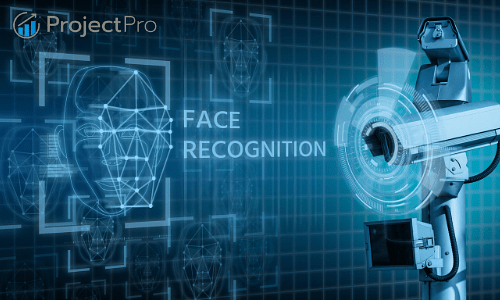
Data Description
The dataset used for this ML project is a video taken from the popular sitcom "Friends". The pictures of the characters Rachel, Chandler, Ross, Monica and Phoebe are taken from the video. In the training dataset, there will be 35 images in total with seven images per person, and in the testing dataset, there will be 15 images.
The first step in this ML project would involve downloading a video from YouTube via Python. Once you load the video, you have to extract frames out of the video to extract faces from the video. Here, you will be making use of the Hear Cascade algorithm for face extraction and extract embeddings from a pre-trained FaceNet model. You will have to modify images as per the requirements of the FaceNet model and train a machine learning model using the embeddings. You will learn to use TSNE to visualize normal embeddings. You will then have to test the model on frames and identify the faces. In this process, you will learn to create VGG Face model architecture.
Language Used : Python
Packages/Libraries: OpenCV, scikit-learn, NumPy, OS, PyTube, scikit_image, skimage, TensorFlow, Keras
Source Code: Build a Face Recognition System in Python using FaceNet
2) Anomaly Detection Using Deep Learning and Autoencoders
Anomaly detection or outlier analysis is a method used in data mining to identify data points that deviate from the expected behaviour. Anomalies in data can occur due to technical glitches or other critical issues and, if not handled properly, can result in incorrect data analysis. Anomaly detection finds applications across the retail, manufacturing, IT and telecom, defence, healthcare, banking, and financial sectors.

Data Description
The dataset used in this project is a credit card fraud dataset that has records of fraudulent and legal transactions across a specific period. The data is in CSV format and has information about the difference in time between one transaction and the previous transaction, the transaction amount, and the classification of fraudulent and non-fraudulent transactions.
You will first import the credit card fraud data and then perform exploratory data analysis. You will learn how to perform data cleaning by imputing null values by picking the correct method. ggplot will help in visualizing the dataset. Next, you will learn to import the H20 library and initialize the H2O cluster. You will have to split the dataset into training and testing data, define the parameters for training the neural network, and train the neural network. You will be able to learn about Autoencoders and how to Autoencode a pre-trained neural network. You will then use ggplot to visualize the effectiveness of an Autoencoded model and neural networks and then finally make predictions using the trained model.
Language Used: R
Packages/Libraries: H2O, caret, e1071, ROCR, ggplot
Source Code: Anomaly Detection Using Deep Learning and Autoencoders
Get Closer To Your Dream of Becoming a Data Scientist with 70+ Solved End-to-End ML Projects
3) Build OCR from Scratch Python using YOLO and Tesseract
You can learn how to build your custom optical character recognition system using Google Tesseract and YOLO through this project. Scanning through digital invoices manually is a tedious job, but we can automate this process. The primary aim of this project is to detect three essential categories from the invoices: invoice number, billing date and total amount. Any field that is currently manually going through bills can make use of this project.
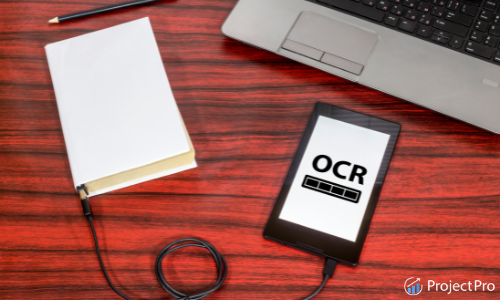
Data Description
YOLOv4 is pre-trained using the coco dataset that has 80 classes that it can predict. This project makes use of these pre-trained weights. Implementation of this project will require you to set up YOLO V4, understanding the YOLO architecture, understanding how to use pre-trained models of YOLO, configuring YOLO to be used on any project and training a custom object detector with YOLO. You will have to configure the Tesseract model as per needs, fine-tune it and use Tesseract pre-trained LSTM.
Language Used - Python
Packages/Libraries - YOLOv4, Tesseract OCR
Source Code - Build OCR from Scratch Python using YOLO and Tesseract
4) Locality Sensitive Hashing Python Code for Lookalike Modelling
Online advertising is a popular way to increase brand awareness. The project aims to build a lookalike model to find which customers are more likely to click on an ad and find an increase in the click rate using the default click rate for reference. Here, you will have to determine the click rate to find the percentage of people who have watched a particular ad online. You will use lookalike models and the LSH algorithm to build larger audiences based on the original users also called seed users.

Data Description
The dataset here is from a company called ‘Adform’. It contains data associated with an online digital campaign where an ad was shown to thousands of people. The dataset contains information on whether the people clicked on the ad or not. Here, you will use only a subset of the data since the dataset is vast.
Lookalike modelling is an interesting use case to solve using the Locality Sensitive Hashing or LSH for large datasets. You will be able to perform calculations using Jaccard similarity on LSH. The project will help you understand more about seed set, model evaluation, ranking users using feature importance and how to filter candidates by performing scoring. You will have to perform data cleaning. The project involves the use of various Python libraries, including NumPy, pandas and datasketch. You will learn how to train a model using the MinHashLSHForest algorithm.
Language Used - Python
Packages- scikit-learn, pandas, numpy, pickle, yaml, datasketch
Source Code- Locality Sensitive Hashing Python Code for Lookalike Modelling
Get Closer To Your Dream of Becoming a Data Scientist with 70+ Solved End-to-End ML Projects
5) Time Series Python Project using Greykite and Neural Prophet
A time series is a sequence of data points collected at regular time intervals for a given entity. The aim here is to identify patterns and trends in the historical data and use the results to forecast the future. Time series analysis is used in supply chains, weather forecasting and biomedical forecasting. In this project, you will learn how time series analysis may be applied for inventory management and sales forecasting.

Data Description
You will use Walmart store sales data. Walmart is an American retail corporation that operates a chain of grocery stores, department stores, and hypermarkets worldwide. The dataset contains the historical sales data associated with 45 different Walmart stores located in different regions. It also contains information regarding the type and size of the store and other data related to the store. You will use the data from the dataset for the historical training data.
In this project, you will perform exploratory data analysis to draw inferences about the features. You will have to perform data cleaning to impute the missing values and identify outliers. You will use the method of feature engineering to extract the day, month and year from the date. The time series component analysis involves identifying trends and season patterns in the data. In this way, you will use Silverkite and Neural Prophet to build the model based on the training data. You can use the mean absolute per cent error and the RMSE methods to perform model validation, after which you will be able to forecast using the trained models.
Language Used - Python
Packages/Libraries- greykite, neural prophet, sci-kit learn, pandas, pandas_profiling, matplotlib, datetime, plotly, seaborn, numpy
Source Code- Time series python project using Greykite and Neural Prophet
Recommended Reading
- 15 Deep Learning Projects Ideas for Beginners to Practice 2021
- 15 Computer Vision Project Ideas for Beginners in 2021
- 15 NLP Projects Ideas for Beginners With Source Code for 2021
- 15 Neural Network Projects Ideas for Beginners to Practice 2021
- 15 Time Series Projects Ideas for Beginners to Practice 2021
- 20+ Data Science Projects for Beginners with Source Code
- 15 Image Processing Projects Ideas in Python with Source Code
- 20 Artificial Intelligence Project Ideas for Beginners to Practice
- 20 Machine Learning Projects That Will Get You Hired in 2021
- 15 Data Visualization Projects for Beginners with Source Code
- 10 MLOps Projects Ideas for Beginners to Practice in 2021
- Access Job Recommendation System Project with Source Code
6) Digit Recognition using CNN for MNIST Dataset in Python
In this machine learning project, you will build a convolutional neural network or CNN to recognize handwritten digits using the MNIST dataset.
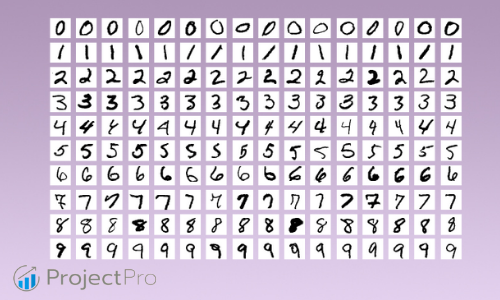
Data Description
The MNIST (Modified National Institute of Standards and Technology) is a widely used dataset in deep learning. It has a training dataset that contains 60,000 grayscale images of handwritten digits between 0 and 9, each of size 28 x 28 pixels and a testing dataset containing 10,000 handwritten digits of the same size.
Key learnings from this project include data visualization and data pre-processing skills, using data reshaping, feature scaling, and a method called One Hot Encoding. The implementation will introduce the CNN model, and you will learn how to build a CNN model and evaluate its performance during training and validation. The model evaluation further involves visualization of the confusion matrix, generating a classification report and monitoring the model's accuracy over the training and validation dataset. You will also get an introduction to Google Vision API, Amazon Rekognition and Azure Computer Vision.
Language Used - Python
Packages/Libraries - Pandas, NumPy, TensorFlow, matplotlib, seaborn, scikit-learn
Source Code - Digit Recognition using CNN for MNIST Dataset in Python
7) Inventory Demand Forecasting
Demand forecasting is a method by which businesses can plan their inventory by estimating the future demand for various products. Demand forecasts help companies to make decisions regarding sales, marketing, finance, production management and logistics. This project aims to forecast inventory demand by building a machine learning model using historical sales data.

Data Description
You will be using a Kaggle dataset, which is from a Mexican multinational company called Grupo Bingo. Group Bingo generates an annual sales volume of 15 billion dollars and is present in countries across the Americas, Europe, Asia and Africa. There is a training dataset with about 7.4 billion entries across 11 features and datasets which contain data about clients, products and the towns with branches.
You will perform exploratory data analysis using various feature engineering techniques and draw inferences from the data. You will then have to perform data cleaning by identifying outliers, missing values and replacing any special characters in the data. You will gain some insight into the significance of the Train test split for model validation as you perform it. While building the model using the training data, you will use the XGBoost, GBM and SVM models. RMSE will be the tool for validating the model.
Language Used - R
Packages/Libraries - dplyr, ggplot2, caTools, xgboost, data.table, Matrix, lightgbm, gbm, caret, zoo, DataCombine, e1071
Source Code- Inventory Demand Forecasting using Machine Learning in R
Get More Practice, More Data Science and Machine Learning Projects, and More guidance.Fast-Track Your Career Transition with ProjectPro
8) Forecasting Business KPI's with Tensorflow and Python
Branding is essential for growth. This project aims to find the key performance indicator metrics for brand logos using a given input clip, such as the number of times a particular brand logo appears and the percentage of the largest and smallest area of the logo. These metrics can help determine brand exposure.
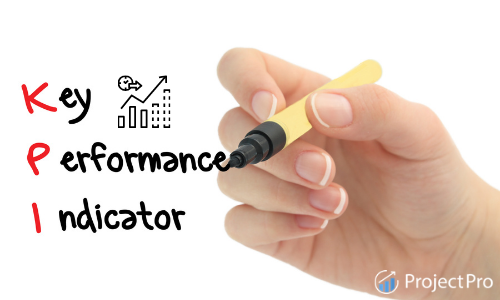
Data Description
The dataset for this project is a video clip of an IPL match played between RCB and CSK. The video has to be downloaded from YouTube and has a duration of 2 minutes 35 seconds.
Once you download the video from YouTube using python, you will have to convert the video clip into frames. Using annotators, you will convert the images to XML files and then convert the XML files into CSV files containing details about the image. You will then convert the CSV files into tfrecords files to train and test the model. You will learn how to use Tensorflow for object detection and understand the base model concept. This project involves understanding the idea of the CKPT file in TensorFlow and generating frozen models from CKPTs. You will then have to make predictions using the trained model and perform any tweaking necessary to obtain the KPI metrics.
Language Used - Python
Packages / Libraries -TensorFlow, pillow, OpenCV, matplotlib, NumPy, UUID
Source Code - Forecasting Business KPI's with Tensorflow and Python
With this, we have covered some innovative ML projects you can practice for August 2021. If you wish to improve your machine learning skills, it is advisable to get hands-on experience working with diverse datasets, libraries, packages, and frameworks. Besides knowing the machine learning algorithm inside-out, you should also know which language, library, and packages would fit in right for implementing any project.
Upcoming Machine Learning Projects for September 2021
- Real-Time Fruit Detection using YOLOv4
- Text Summarization using BART
- Language Translation Model from Scratch
- RASA NLU Chatbot Creation
- Building a Medical Search Engine
Bookmark this blog for more Innovative Machine Learning Project Ideas! Go ahead and master your machine learning skills by trying out these machine learning project ideas to build a job-winning machine learning portfolio!
About the Author
ProjectPro
ProjectPro is the only online platform designed to help professionals gain practical, hands-on experience in big data, data engineering, data science, and machine learning related technologies. Having over 270+ reusable project templates in data science and big data with step-by-step walkthroughs,



